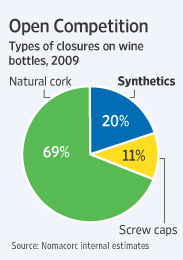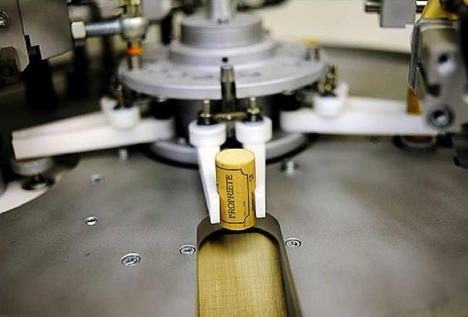“A machine makes Portugal whine.” Source of caption: print version of the WSJ article quoted and cited below. Source of photo: online version of the WSJ article quoted and cited below.
(p. A1) ZEBULON, N.C.–In a nondescript factory in this small, wooded town, 10 giant machines worked around the clock last year to churn out 1.4 billion plastic corks, enough to circle the earth 1.33 times if laid end-to-end.
Unknown to most American wine drinkers, the plant’s owner, Nomacorc LLC, has quietly revolutionized the 400-year-old wine-cork industry. Since the 1600s, wine has been bottled almost exclusively with natural cork, a porous material that literally grows on trees in Portugal, Spain and other Mediterranean lands.
But over the past 10 years, an estimated 20% of the bottle stopper market has been replaced by a new technology–plastic corks that cost between 2 and 20 cents apiece. More than one in 10 full-sized wine bottles sold worldwide now come with a Nomacorc plug, while another 9% or so come from other plastic cork makers. Screw caps took another 11% of the market.
“We infuriated the cork industry,” says Marc Noel, Nomacorc’s chairman.
. . .
The story of how Nomacorc and other stop-(p. A10)per upstarts broke the centuries-old cork monopoly is a lesson in how innovation, timing and hustle combined to exploit an opening in a once airtight market. It shows that any dominant industry can be vulnerable to competition, especially if it grows complacent about its position.
For the full story, see:
TIMOTHY AEPPEL. “Show Stopper: How Plastic Popped the Cork Monopoly.” The Wall Street Journal (Sat., MAY 1, 2010): A1 & A10.
(Note: ellipsis added.)

Source of graph: online version of the WSJ article quoted and cited above.


